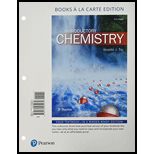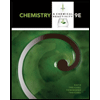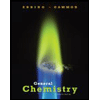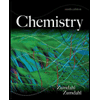
Introductory Chemistry, Books a la Carte Plus Mastering Chemistry with Pearson eText -- Access Card Package (6th Edition)
6th Edition
ISBN: 9780134557311
Author: Nivaldo J. Tro
Publisher: PEARSON
expand_more
expand_more
format_list_bulleted
Concept explainers
Textbook Question
Chapter 6, Problem 6SAQ
How many moles of O are in 1.6 mol of Ca(N03)2
?
1.6 mol O
3.2 mol O
4.8 mol O
9.6 mol O
Expert Solution & Answer
Trending nowThis is a popular solution!

Students have asked these similar questions
The Davies equation corrects the Debye-Hückel limiting law for calculating the
activity coefficient of an electrolyte in solution at relatively high concentrations.
Mathematically, it is expressed as: log y₁ = -Az²?
1 + √Ĩ
- 0,31)
Is the formula correct?
Differentiate between the concepts of "ionic salt effect" and "kinetic salt effect."
Differentiate the concepts of “salino effect” and “salino kinetic effect”.
Chapter 6 Solutions
Introductory Chemistry, Books a la Carte Plus Mastering Chemistry with Pearson eText -- Access Card Package (6th Edition)
Ch. 6 - Q1. How many atoms are there in 5.8 mol helium?
a....Ch. 6 - A sample of pure silver has a mass of 155g How...Ch. 6 - How many carbon atoms are there in a 12.5kg sample...Ch. 6 - Q4. Which sample contains the greatest number of...Ch. 6 - Q5. What is the average mass (in grams) of a...Ch. 6 - Q6. How many moles of O are in 1.6 mol of?
1.6 mol...Ch. 6 - Q7. How many grams of Cl are in?
Ch. 6 - Q8. Which sample contains the greatest number of F...Ch. 6 - Q9. The compound is 35.8% A by mass. What mass of...Ch. 6 - Q10. Which compound has the highest mass percent...
Ch. 6 - What is the mass percent N in C2H8N2 ? a. 23.3% N...Ch. 6 - Q12. A compound is 52.14% C, 13.13% H, and 34.73%...Ch. 6 - A compound has the empirical formula CH2O and a...Ch. 6 - Prob. 14SAQCh. 6 - Why is chemical composition important?Ch. 6 - 2. How can you efficiently determine the number of...Ch. 6 - How many atoms are in 1 mol of atoms?Ch. 6 - 4. How many molecules are in 1 mol of molecules?
Ch. 6 - 5. What is the mass of 1 mol of atoms for an...Ch. 6 - What is the mass of 1 mol of molecules for a...Ch. 6 - What is the mass of 1 mol atoms of each element?...Ch. 6 - 8. What is the mass of 1 mol of molecules of each...Ch. 6 - 9. The subscripts in a chemical formula give...Ch. 6 - 10 Write the conversion factors between moles of...Ch. 6 - Prob. 11ECh. 6 - 12. What is the mathematical formula for...Ch. 6 - How are the empirical formula and the molecular...Ch. 6 - 14. Why is it important to be able to calculate an...Ch. 6 - 15. What is the empirical formula mass of a...Ch. 6 - 16. How are the molar mass and empirical formula...Ch. 6 - How many mercury atoms are in 5.8mol of mercury?Ch. 6 - 18. How many moles of gold atoms do gold atoms...Ch. 6 - How many atoms are in each elemental sample? a....Ch. 6 - 20. How many moles of atoms are in each elemental...Ch. 6 - Complete the table. Element Moles Number of Atoms...Ch. 6 - 22. Complete the table.
Element Moles Number of...Ch. 6 - Consider these definitions. 1 doz =12 1gross =144...Ch. 6 - 24. A pure copper penny contains approximately ...Ch. 6 - 25. How many moles of tin atoms are in a pure tin...Ch. 6 - 26. A lead fishing weight contains 0.12 mol of...Ch. 6 - 27. A pure gold coin contains 0.145 mol of gold....Ch. 6 - 28. A helium balloon contains 0.46 g of helium....Ch. 6 - How many moles of atoms are in each elemental...Ch. 6 - 30. What is the mass in grams of each elemental...Ch. 6 - Complete the table. Element Mole Mass Ne ____...Ch. 6 - Complete the table. Element Moles Mass Cr 0.00442...Ch. 6 - 33. Apure silver ring contains mmol (millmol) Ag....Ch. 6 - A pure gold ring contains 0.0102 mmol (millmol)...Ch. 6 - How many aluminum atoms are in 3.78 g of aluminum?Ch. 6 - 36. What is the mass of platinum atoms?
Ch. 6 - How many atoms are in each elemental sample? a....Ch. 6 - Calculate the mass in grams of each elemental...Ch. 6 - 39. How many carbon atoms are in a diamond (pure...Ch. 6 - How many helium atoms are in a helium blimp...Ch. 6 - 41. How many titanium atoms are in a pure titanium...Ch. 6 - 42. How many copper atoms are in a pure copper...Ch. 6 - 43. Complete the table.
Element Mass Moles Number...Ch. 6 - 44. Complete the table.
Element Mass Moles Number...Ch. 6 - Which sample contains the greatest number of...Ch. 6 - Which sample contains the greatest number of...Ch. 6 - 47. Determine the number of molecules (or formula...Ch. 6 - 48. Determine the mass of each sample.
a. mol...Ch. 6 - 49. Complete the table.
Compound Mass Moles Number...Ch. 6 - 50. Complete the table.
Compound Mass Moles Number...Ch. 6 - A mothball, composed of naphthalene (C10H8), has a...Ch. 6 - Calculate the mass in grams of a single water...Ch. 6 -
53. How many molecules are in each sample?
a.
b....Ch. 6 -
54. Calculate the mass in grams of each...Ch. 6 - 55. A sugar crystal contains approximately sucrose...Ch. 6 - A salt crystal has a mass of 0.12 mg. How many...Ch. 6 - How much money, in dollars, dose 1 mol of pennies...Ch. 6 - A typical dust particle has a diameter of about...Ch. 6 - 59. Determine the number of moles of in mol .
Ch. 6 - 60. How many moles of O are in mol ?
Ch. 6 - 61. Which sample contains the greatest number of...Ch. 6 - Prob. 62ECh. 6 - Determine the number of moles of C in each sample....Ch. 6 - Determine the number of moles of H in each sample....Ch. 6 - 65. For each set of molecular models, write a...Ch. 6 - 66. For each set of molecular models, write a...Ch. 6 - 67. How many grams of are in 38.0 g of each...Ch. 6 - 68. Calculate the number of grams of sodium in...Ch. 6 - Iron is found in Earths crust as several different...Ch. 6 - 70. Lead is found in Earth’s crust as several lead...Ch. 6 - A 2.45-g sample of strontium completely reacts...Ch. 6 - A 4.78-g sample of aluminum completely reacts with...Ch. 6 - A 1.912g sample of calcium chloride is decomposed...Ch. 6 - Prob. 74ECh. 6 - 75. Copper(II) fluoride contains 37.42% F by mass....Ch. 6 - Silver chloride, used in silver plating, contains...Ch. 6 - In small amounts, the fluoride ion (often consumed...Ch. 6 - The iodide ion, usually consumed as potassium...Ch. 6 - 79. Calculate the mass percent composition of...Ch. 6 - Calculate the mass percent composition of carbon...Ch. 6 - 81. Calculate the mass percent composition of each...Ch. 6 - 82. Calculate the mass percent composition of each...Ch. 6 - 83. Calculate the mass percent composition of O in...Ch. 6 - Calculate the mass percent composition of Cl in...Ch. 6 - Various iron ores have different amounts of iron...Ch. 6 - 86. Plats need nitrogen to grow, so many...Ch. 6 - 87. A compound containing nitrogen and oxygen is...Ch. 6 - 88. A compound containing selenium and fluorine is...Ch. 6 - 89. Samples of several compounds are decomposed,...Ch. 6 - Samples of several compounds are decomposed, and...Ch. 6 - 91. The rotten smell of a decaying animal carcass...Ch. 6 - 92. Citric acid, the compound responsible for the...Ch. 6 - 93. These compounds are found in many natural...Ch. 6 - Calculate the empirical formula for each...Ch. 6 - 95. A sample of phosphorus burns in air and forms...Ch. 6 - A 2.241-g sample of nickel reacts with oxygen to...Ch. 6 - A sample of nitrogen reacts with chlorine to form...Ch. 6 - 98. A sample of phosphorus reacts with selenium...Ch. 6 - 99. A compound containing carbon and hydrgen has a...Ch. 6 - A compound containing phosphorus and oxygen has a...Ch. 6 - 101. The molar masses and empirical formulas of...Ch. 6 - The molar masses and empirical formulas of several...Ch. 6 - 103. A. pure copper cube has an edge length of...Ch. 6 - Prob. 104ECh. 6 - A drop of water has a volume of approximately 0.05...Ch. 6 - Fingernail-polish remover is primarily acetone...Ch. 6 - 107. Complete the...Ch. 6 - Prob. 108ECh. 6 - Determine the chemical formula of each compound...Ch. 6 - Prob. 110ECh. 6 - Prob. 111ECh. 6 - Prob. 112ECh. 6 - 113. A leak in the air conditioning system of an...Ch. 6 - 114. A leak in the air conditioning system of an...Ch. 6 - 115. Hydrogen is a possible future fuel. However,...Ch. 6 - Prob. 116ECh. 6 - Complete the table of compounds that contain only...Ch. 6 - 118. Complete the table of compounds that contain...Ch. 6 - Butanedione, a component of butter and body odor,...Ch. 6 - 120. Caffeine, a stimulant found in coffee and...Ch. 6 - 121. Nicotine, a stimulant found tobacco, has the...Ch. 6 - Prob. 122ECh. 6 - 123. A sample contains both KBr and KI in unknown...Ch. 6 - 124. A sample contains both and Ne in unknown...Ch. 6 - Ethanethiol (C2H6S) is a compound with a...Ch. 6 - 126. Methanethiol has a disagreeable odor and is...Ch. 6 - Prob. 127ECh. 6 - Prob. 128ECh. 6 - you can use the concepts in this chapter to obtain...Ch. 6 - Prob. 130ECh. 6 - 131. In 1996, the media reported that possible...Ch. 6 - 132. Using grammatically correct English...Ch. 6 - Discuss these questions with the group and record...Ch. 6 - Amylose is a polysaccharide that plants use to...
Knowledge Booster
Learn more about
Need a deep-dive on the concept behind this application? Look no further. Learn more about this topic, chemistry and related others by exploring similar questions and additional content below.Similar questions
- Come and compare the Bronsted-Bjerrum calculation, the Debye and Hückel calculation, and the Davies calculation.arrow_forwardplz watch the youtube video (the title of this topic) by roxi H. she explains it step by step but i get the wrong answerarrow_forwardWriting the rate law implied by a simple mechanism To exit full screen, press and hold esc Suppose the decomposition of ozone proceeds by the following mechanism: step elementary reaction rate constant 1 →>> O3(9) O2(g) + O(g) k₁ 2 03(g) + O(g) → 202(g) k2 Suppose also k₁ »k2. That is, the first step is much faster than the second. Write the balanced chemical equation for the overall chemical reaction: Write the experimentally- observable rate law for the overall chemical reaction. ☐ rate = ☐ Note: your answer should not contain the concentrations of any intermediates. Express the rate constant k for the overall chemical reaction in terms of K1, K2, and (if necessary) the rate constants k-1 and K-2 for the reverse of the two elementary reactions in the mechanism. k = ☐ 000 18 ローロ Ar OOarrow_forward
- Deducing a rate law from the change in concentration over time To exit full screen, press and hold esc A chemistry graduate student is studying the rate of this reaction: H2CO3(aq) → H₂O(aq) +CO₂ (aq) - She fills a reaction vessel with H2CO3 and measures its concentration as the reaction proceeds: time (milliseconds) [H2CO3] 0 0.0500 M 10. 0.0266M 20. 0.0181 M 30. 0.0138M 40. 0.0111 M Use this data to answer the following questions. Write the rate law for this reaction. Calculate the value of the rate constant k. Round your answer to 2 significant digits. Also be sure your answer has the correct unit symbol. rate ☐ x10 k = Х 000 18 Ararrow_forwardWriting the rate law implied by a simple mechanism Suppose the formation of tert-butanol proceeds by the following mechanism: step elementary reaction 1 (CH3)3 CBr(aq) → (CH3)2 C* (aq) + Br (aq) 2 (CH3)2C (aq) + OH¯ (aq) → (CH3)2COH(aq) rate constant k₁ k₂ Suppose also k₁ »k2. That is, the first step is much faster than the second. Write the balanced chemical equation for the overall chemical reaction: Write the experimentally- observable rate law for the overall chemical reaction. Note: your answer should not contain the concentrations of any intermediates. rate = k ☐ Express the rate constant k for the overall chemical reaction in terms of K1, K2, and (if necessary) the rate constants k-1 and K-2 for the reverse of the two elementary reactions in the mechanism. k = ☐ □ ☑ G ? 00. 18 Ar Barrow_forwardDeducing a rate law from the change in concentration over time A chemistry graduate student is studying the rate of this reaction: 2SO3 (g) →>> 2SO2 (g) + O2(g) He fills a reaction vessel with SO3 and measures its concentration as the reaction proceeds: ? time (minutes) [SO3] 0 0.0200M 1.0 0.0105 M 2.0 0.00552M 3.0 0.00290M 4.0 0.00152M Use this data to answer the following questions. Write the rate law for this reaction. rate = k ☐ x10 Calculate the value of the rate constant k. Round your answer to 2 significant digits. Also be sure your answer has the correct unit symbol. k = ☐ Х 000 18 Ar BAarrow_forward
- Using the Arrhenius equation to calculate k at one temperature from k at... The rate constant of a certain reaction is known to obey the Arrhenius equation, and to have an activation energy E reaction is 1.2 × 107 M −1 .S at 160.0 °C, what will the rate constant be at 194.0 °C? Round your answer to 2 significant digits. k = Шм −1 -1 .S ☐ x10 ☑ 5 = = 16.0 kJ/mol. If the rate constant of this a ? olo Ar Barrow_forwardUsing the Arrhenius equation to calculate k at one temperature from k at... a The rate constant of a certain reaction is known to obey the Arrhenius equation, and to have an activation energy E = 10.0 kJ/mol. If the rate constant of this reaction is 9.9 × 107 M -1 .S at 246.0 °C, what will the rate constant be at 196.0 °C? Round your answer to 2 significant digits. k = ☐ M -1 −1 .S x10 ☑ ? 00. 18 Ar Barrow_forwardWriting the rate law implied by a simple mechanism Suppose the reaction between nitric oxide and bromine proceeds by the following mechanism: elementary reaction - NO(g) + Br2(g) → NOBг2(g) step 1 2 NOBг2(g) + NO(g) - rate constant k₁ 2 NOBr(g) k2 Suppose also k₁ »k2. That is, the first step is much faster than the second. Write the balanced chemical equation for the overall chemical reaction: Write the experimentally- observable rate law for the overall chemical reaction. Note: your answer should not contain the concentrations of any intermediates. ☐ rate = k Express the rate constant k for the overall chemical reaction in terms of k₁, k2, and (if necessary) the rate constants k-1 and K-2 for the reverse of the two elementary reactions in the mechanism. = ☐ ロ→ロ Х ك ? 000 18 Ararrow_forward
- Deducing a rate law from the change in concentration over time chemistry graduate student is studying the rate of this reaction: 2H3PO4 (aq) → P₂O5 (aq) +3H₂O (aq) 2 e fills a reaction vessel with H3PO and measures its concentration as the reaction proceeds: 4 time (seconds) [H3PO4] 0 0.500M 1.0 0.229 M 2.0 0.148M 3.0 0.110M 4.0 0.0871 M se this data to answer the following questions. Write the rate law for this reaction. rate = k x10 Calculate the value of the rate constant k. k = Round your answer to 2 significant digits. Also be sure your answer has the correct unit symbol. ☑ G olo 18 Ararrow_forwardWriting the rate law implied by a simple mechanism Suppose the formation of nitrosyl chloride proceeds by the following mechanism: elementary reaction step rate constant 1 NO(g) + Cl2(g) → NOC₁₂(g) k₁ 2 NOCl2(g) + NO(g) 2 NOCl(g) →>> k2 Suppose also k₁ »k. That is, the first step is much faster than the second. Write the balanced chemical equation for the overall chemical reaction: Write the experimentally- observable rate law for the overall chemical reaction. rate = k ☐ Note: your answer should not contain the concentrations of any intermediates. Express the rate constant k for the overall chemical reaction in terms of K1, K2, and (if necessary) the rate constants k-1 and K-2 for the reverse of the two elementary reactions in the mechanism. k = | Х ? 18 Ararrow_forwardUsing first- and second-order integrated rate laws 1/5 Consider this reaction: H2CO3(aq) → H₂O (aq) +CO₂ (aq) At a certain temperature it obeys this rate law. rate = (2.27 s¹) [H2CO3] Suppose a vessel contains H2CO3 at a concentration of 0.830M. Calculate how long it takes for the concentration of H2CO3 to decrease by 83.0%. You may assume no other reaction is important. Round your answer to 2 significant digits. S x10 ☑ § ? 00. 18 Ararrow_forward
arrow_back_ios
SEE MORE QUESTIONS
arrow_forward_ios
Recommended textbooks for you
 Chemistry & Chemical ReactivityChemistryISBN:9781133949640Author:John C. Kotz, Paul M. Treichel, John Townsend, David TreichelPublisher:Cengage Learning
Chemistry & Chemical ReactivityChemistryISBN:9781133949640Author:John C. Kotz, Paul M. Treichel, John Townsend, David TreichelPublisher:Cengage Learning Chemistry: Principles and PracticeChemistryISBN:9780534420123Author:Daniel L. Reger, Scott R. Goode, David W. Ball, Edward MercerPublisher:Cengage Learning
Chemistry: Principles and PracticeChemistryISBN:9780534420123Author:Daniel L. Reger, Scott R. Goode, David W. Ball, Edward MercerPublisher:Cengage Learning Chemistry: An Atoms First ApproachChemistryISBN:9781305079243Author:Steven S. Zumdahl, Susan A. ZumdahlPublisher:Cengage Learning
Chemistry: An Atoms First ApproachChemistryISBN:9781305079243Author:Steven S. Zumdahl, Susan A. ZumdahlPublisher:Cengage Learning General Chemistry - Standalone book (MindTap Cour...ChemistryISBN:9781305580343Author:Steven D. Gammon, Ebbing, Darrell Ebbing, Steven D., Darrell; Gammon, Darrell Ebbing; Steven D. Gammon, Darrell D.; Gammon, Ebbing; Steven D. Gammon; DarrellPublisher:Cengage Learning
General Chemistry - Standalone book (MindTap Cour...ChemistryISBN:9781305580343Author:Steven D. Gammon, Ebbing, Darrell Ebbing, Steven D., Darrell; Gammon, Darrell Ebbing; Steven D. Gammon, Darrell D.; Gammon, Ebbing; Steven D. Gammon; DarrellPublisher:Cengage Learning ChemistryChemistryISBN:9781305957404Author:Steven S. Zumdahl, Susan A. Zumdahl, Donald J. DeCostePublisher:Cengage Learning
ChemistryChemistryISBN:9781305957404Author:Steven S. Zumdahl, Susan A. Zumdahl, Donald J. DeCostePublisher:Cengage Learning

Chemistry & Chemical Reactivity
Chemistry
ISBN:9781133949640
Author:John C. Kotz, Paul M. Treichel, John Townsend, David Treichel
Publisher:Cengage Learning

Chemistry: Principles and Practice
Chemistry
ISBN:9780534420123
Author:Daniel L. Reger, Scott R. Goode, David W. Ball, Edward Mercer
Publisher:Cengage Learning

Chemistry: An Atoms First Approach
Chemistry
ISBN:9781305079243
Author:Steven S. Zumdahl, Susan A. Zumdahl
Publisher:Cengage Learning

General Chemistry - Standalone book (MindTap Cour...
Chemistry
ISBN:9781305580343
Author:Steven D. Gammon, Ebbing, Darrell Ebbing, Steven D., Darrell; Gammon, Darrell Ebbing; Steven D. Gammon, Darrell D.; Gammon, Ebbing; Steven D. Gammon; Darrell
Publisher:Cengage Learning

Chemistry
Chemistry
ISBN:9781305957404
Author:Steven S. Zumdahl, Susan A. Zumdahl, Donald J. DeCoste
Publisher:Cengage Learning

Step by Step Stoichiometry Practice Problems | How to Pass ChemistryMole Conversions Made Easy: How to Convert Between Grams and Moles; Author: Ketzbook;https://www.youtube.com/watch?v=b2raanVWU6c;License: Standard YouTube License, CC-BY